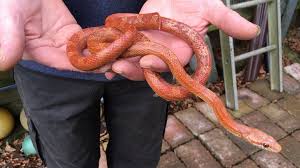Reptiles originate from hot, dry deserts or habitats with very specific requirements for their survival.
It is very important when considering whether to keep a reptile as a pet, that you understand what sort of controlled environment you will need to provide, and that you learn as much as you can about how to care for them beforehand. At PAWS we have the knowledge and expertise to guide you in caring for your reptile. On these pages we have provided some general information and guidelines about caring for the most popular reptiles, however, we advise that you come and visit us in the shop for a chat about your reptile's specific needs.
 Corn snakes are even-tempered and have many different colour variations including blood red, striped and albino. They become tame with regular handling, do not grow very big compared to other species and make the ideal first snake.
Corn snakes are even-tempered and have many different colour variations including blood red, striped and albino. They become tame with regular handling, do not grow very big compared to other species and make the ideal first snake.
Housing
A well ventilated, heated, escape-proof vivarium is the best housing for your corn snake.
The size of the vivarium you’ll need should be calculated as follows: diagonal of the cage floor = more than half of the snake’s length.
Furnishing
Bark or wood shavings are an ideal substrate material.
Avoid newspaper as this is too slippery and can damage the snake’s spine
Provide a hide for the snake at the cool end as well as the hotter end of the vivarium to give the snake a choice.
Provide a climbing branch and artificial plants

Temperature
Corn snakes need a hot area of around 32°C, with a background daytime temperature of 27°C. At night the temperature should drop to around 22°C.
Gentle heat can be provided using heat mat or heat rocks which are an appropriate size for the vivarium.
More intense heat can be provided using spotlights or heat lamps.
Lighting
Corn snakes do not need UVA or UVB lighting as they are mostly nocturnal.
Provide an incandescent daylight bulb or a Reptiglo 2.0 flourescent tube that can be set on a timer to give 10-12 hours of daylight.
A Night Glo bulb could help with nocturnal viewing if required
Diet & Feeding
Corn snakes are carnivores and feed on defrosted mice or rats of an appropriate size, as they consume their food whole.
Young snakes can be fed every 2-5 days and adults every 7-14 days.
Handling
Hold your snake loosely, supporting the middle and the rear of the body. Your movements should be slow and deliberate.
Always wash your hands after handling your snake as reptiles can carry a form salmonella, so good hygiene practice is important.
Never handle your snake just before, during or just after feeding as this is likely to result in a bite.

